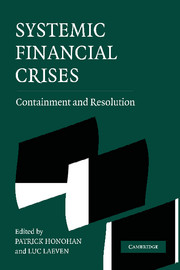Book contents
- Frontmatter
- Contents
- Contributors
- Foreword
- Acknowledgments
- PART ONE INTRODUCTION
- PART TWO CONTAINMENT AND RESOLUTION
- PART THREE MODELS AND ECONOMETRIC EVIDENCE
- PART FOUR STRUCTURAL REFORMS
- 7 Financial Crises and the Presence of Foreign Banks
- 8 Maximizing the Value of Distressed Assets: Bankruptcy Law and the Efficient Reorganization of Firms
- 9 Crisis Resolution and Credit Allocation: The Case of Japan
- Appendix: Banking Crisis Database
- References
- Index
7 - Financial Crises and the Presence of Foreign Banks
Published online by Cambridge University Press: 24 August 2009
- Frontmatter
- Contents
- Contributors
- Foreword
- Acknowledgments
- PART ONE INTRODUCTION
- PART TWO CONTAINMENT AND RESOLUTION
- PART THREE MODELS AND ECONOMETRIC EVIDENCE
- PART FOUR STRUCTURAL REFORMS
- 7 Financial Crises and the Presence of Foreign Banks
- 8 Maximizing the Value of Distressed Assets: Bankruptcy Law and the Efficient Reorganization of Firms
- 9 Crisis Resolution and Credit Allocation: The Case of Japan
- Appendix: Banking Crisis Database
- References
- Index
Summary
INTRODUCTION
Foreign banks have entered many transition and emerging economies in recent years, sometimes before economic and banking crises have developed, and often after. Today, in a number of countries foreign banks own as much as 90 percent or more of the banking systems' assets. The question then naturally arises as to what the effect of the foreign presence is on crises, especially on preventing or ameliorating them, in addition to their possible role in the restructuring phase already flagged in Chapter 2.
This Chapter first discusses the motives, modes, and regulation of foreign banks. In analyzing foreign entry, it is important to distinguish between classic or traditional foreign banks and the innovators, which in turn one can classify either as “bettors,” “prospectors,” or “restructurers.” Innovators enter in response to the opportunities that crises create, but this chapter argues that their entry and the reforms that accompany it erode the very conditions that drew the banks. In the long run, then, it may well be that the relative and possibly even absolute importance of foreign-owned banks in host-country banking systems may shrink. A further distinction is in the mode of entry, as among affiliate, branch, and subsidiary, a choice that is largely based on the foreigners' motives for entry.
Section 2 observes that foreign banks have in most cases not played an important role in the emergence of crises, primarily because they did not have a significant presence before the crisis began.
- Type
- Chapter
- Information
- Systemic Financial CrisesContainment and Resolution, pp. 197 - 231Publisher: Cambridge University PressPrint publication year: 2005
- 13
- Cited by



